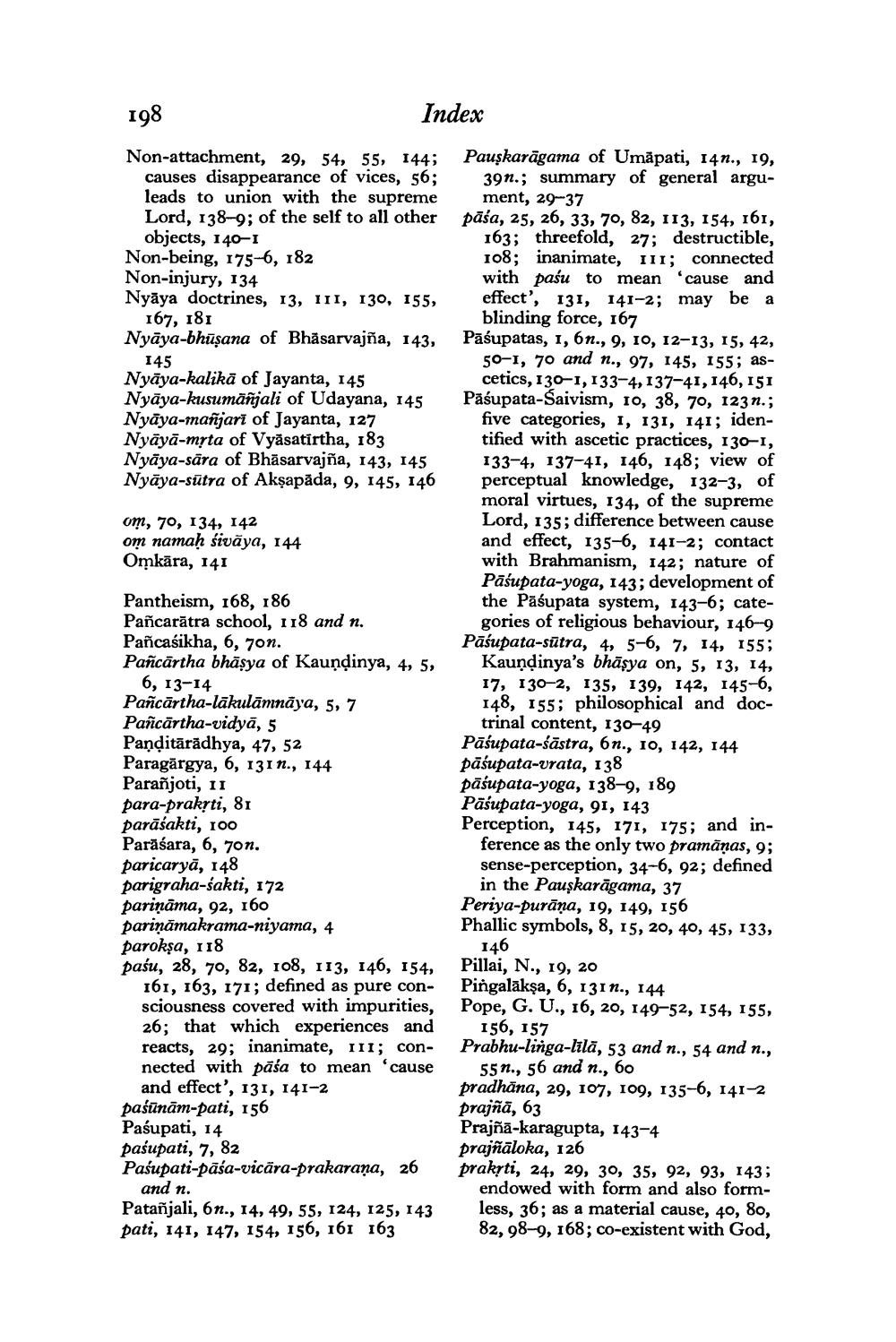Book Title: History of Indian Philosophy
Author(s): Surendranath Dasgupta
Publisher: Cambridge University Press
View full book text
________________
198
Index
Non-attachment, 29, 54, 55, 144;
causes disappearance of vices, 56; leads to union with the supreme Lord, 138-9; of the self to all other
objects, 140-1 Non-being, 175-6, 182 Non-injury, 134 Nyāya doctrines, 13, 11, 130, 155,
167, 181 Nyāya-bhūşana of Bhāsarvajña, 143,
145 Nyāya-kalikā of Jayanta, 145 Nyāya-kusumāñjali of Udayana, 145 Nyāya-mañjarī of Jayanta, 127 Nyāyā-myta of Vyāsatirtha, 183 Nyāya-sära of Bhāsarvajña, 143, 145 Nyāya-sūtra of Akşapāda, 9, 145, 146
om, 70, 134, 142 om namaḥ śivāya, 144 Omkāra, 141
Pantheism, 168, 186 Pañcarātra school, 118 and n. Pañcaśikha, 6, 70n. Pañcārtha bhāşya of Kaundinya, 4, 5,
6, 13-14 Pañcārtha-lākulāmnāya, 5, 7 Pañcārtha-vidyā, 5 Panditārādhya, 47, 52 Paragärgya, 6, 1311., 144 Parañjoti, 11 para-prakyti, 81 parāśakti, roo Parāśara, 6, 70n. paricaryā, 148 parigraha-sakti, 172 pariņāma, 92, 160 parināmakrama-niyama, 4 parokşa, 118 paśu, 28, 70, 82, 108, 113, 146, 154,
161, 163, 171; defined as pure con- sciousness covered with impurities, 26; that which experiences and reacts, 29; inanimate, III; con- nected with pāśa to mean 'cause
and effect', 131, 141-2 paśūnām-pati, 156 Pasupati, 14 pasupati, 7, 82 Pasupati-pāśa-vicāra-prakarana, 26
and n. Patanjali, 6n., 14, 49, 55, 124, 125, 143 pati, 141, 147, 154, 156, 161 163
Pauskarāgama of Umāpati, 14n., 19,
39n.; summary of general argu
ment, 29-37 pāśa, 25, 26, 33, 70, 82, 113, 154, 161,
163; threefold, 27; destructible, 108; inanimate, II; connected with paśu to mean 'cause and effect', 131, 141-2; may be a
blinding force, 167 Pāśupatas, 1, 6n., 9, 10, 12-13, 15, 42,
50-1, 70 and n., 97, 145, 155; as
cetics, 130-1,133-4, 137-41, 146, 151 Pāśupata-Saivism, ro, 38, 70, 123n.;
five categories, 1, 131, 141; identified with ascetic practices, 130-1, 133-4, 137-41, 146, 148; view of perceptual knowledge, 132–3, of moral virtues, 134, of the supreme Lord, 135; difference between cause and effect, 135-6, 141-2; contact with Brahmanism, 142; nature of Pāśupata-yoga, 143; development of the Pāśupata system, 143-6; cate
gories of religious behaviour, 146-9 Pāśupata-sūtra, 4, 5-6, 7, 14, 155;
Kauņdinya's bhāşya on, 5, 13, 14, 17, 130-2, 135, 139, 142, 145-6, 148, 155; philosophical and doc
trinal content, 130-49 Pāśupata-śāstra, 6n., 10, 142, 144 pāśupata-vrata, 138 pāśupata-yoga, 138-9, 189 Pāśupata-yoga, 91, 143 Perception, 145, 171, 175; and in
ference as the only two pramānas, 9; sense-perception, 34-6, 92; defined
in the Pauskarāgama, 37 Periya-purāna, 19, 149, 156 Phallic symbols, 8, 15, 20, 40, 45, 133,
146 Pillai, N., 19, 20 Pingalakşa, 6, 131n., 144 Pope, G. U., 16, 20, 149-52, 154, 155,
156, 157 Prabhu-linga-līlā, 53 and n., 54 and n.,
551., 56 and n., 60 pradhāna, 29, 107, 109, 135-6, 141-2 Prajĩa, 63 Prajñā-karagupta, 143-4 prajñāloba, 126 prakyti, 24, 29, 30, 35, 92, 93, 143;
endowed with form and also formless, 36; as a material cause, 40, 80, 82, 98-9, 168; co-existent with God,

Page Navigation
1 ... 2508 2509 2510 2511 2512 2513 2514 2515 2516 2517
